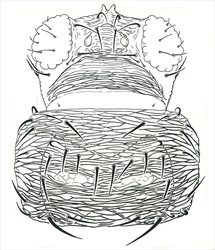
Head & pronotum

Antenna

Antenna
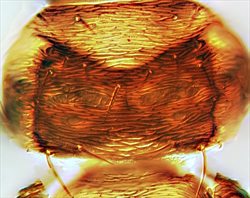
Pronotum
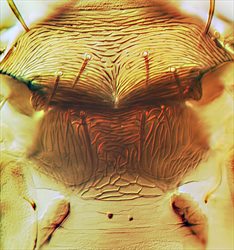
Meso & metanota
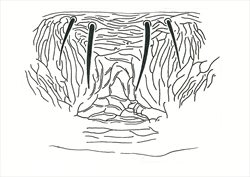
Metanotum
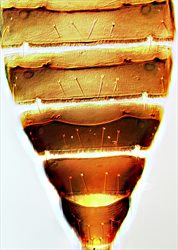
Tergites V-IX

Tergites III-IV
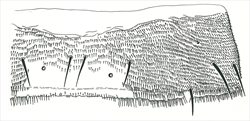
Tergite III

Fore wing
Both sexes fully winged. Female dark brown, apex of fore femur paler, fore tibia brownish yellow; fore wing dark brown with sub-basal pale band, clavus yellow at apex; antennal segment I brown basally, yellow at apex, II yellow, III shaded, remaining segments brown. Head transversely striate, mouth cone extending between fore coxae; maxillary palps 3-segmented; occipital apodeme close to but not confluent with posterior margin of eyes; ocellar triangle weakly and irregularly reticulate; ocellar setae III within ocellar triangle. Pronotum with transversely anastomosing striae; mesonotum with transverse striations. Metanotum with linear reticulation. Metasternal plate with anterior margin almost straight. Fore wing first vein with complete setal row, second vein with one seta. Tergite posterior margins each with a craspedum; VII–VIII with posteromarginal comb medially; tergite IX with 2 pairs of mid-dorsal setae; sternites II–VI with craspedum.
Male similar to female but smaller, sternites IV–VII with small oval pore plate.
The monophyly of Thripidae subfamily Sericothripinae was recently confirmed by Lima & Mound (2016), and the current concept of three valid genera within the subfamily follows Wang (2007) and Mound & Tree (2009). The genus Neohydatothrips currently comprises 117 species. These are found widely around the tropics and subtropics, with only gracilicornis known from Britain. However, four other species are recorded in the genus from Europe (zur Strassen, 2003). In contrast to the species placed in Sericothrips, the species of Neohydatothrips have part of the median area of the tergites without microtrichia.
Apparently feeding and breeding on leaves rather than in flowers, and usually associated with Vicia cracca [Fabaceae]. However, in Italy this thrips has been recorded in association with damage to the needles of Pinus (Marullo, 1990).
Described from material taken near Oxford (Williams, 1916), and found in Britain only in the southeast quarter of England as far north as Lincoln and Norfolk (Mound et al., 1976). This species is widespread across the Palaearctic to Japan and China (zur Strassen, 2003), and in Europe south to Spain and Greece, and beyond to Morocco and Iran.
THRIPIDAE - SERICOTHRIPINAE
Neohydatothrips gracillicornis (Williams)
Sericothrips gracillicornis Williams, 1916: 222
Taeniothrips karafutensis Ishida, 1931: 36
Lima EFB & Mound LA (2016) Systematic relationships of the Thripidae subfamily Sericothripinae (Insecta: Thysanoptera) Zoologischer Anzeiger 263: 24–32.
Marullo R (1990) Attacchi di Neohydatothrips gracilicornis (Williams) (Thysanoptera, Thripidae) su Pinus sp.. Redia 73: 223–228.
Mound LA, Morison GD, Pitkin BR & Palmer JM (1976) Thysanoptera. Handbooks for the Identification of British Insects 1 (11): 1–79.
Mound LA & Tree DJ (2009) Identification and host-plant associations of Australian Sericothripinae (Thysanoptera, Thripidae). Zootaxa 1983: 1–22.
Wang C-L (2007) Hydatothrips and Neohydatothrips (Thysanoptera, Thripidae) of East and South Asia with three new species from Taiwan. Zootaxa 1575: 47–68.
Williams CB (1916) Biological and systematic notes on British Thysanoptera. The Entomologist 49: 221-227; 243-245; 275–284.
zur Strassen, R (2003) Die terebranten Thysanopteren Europas und des Mittelmeer-Gebietes. Die Tierwelt Deutschlands 74: 1–271.